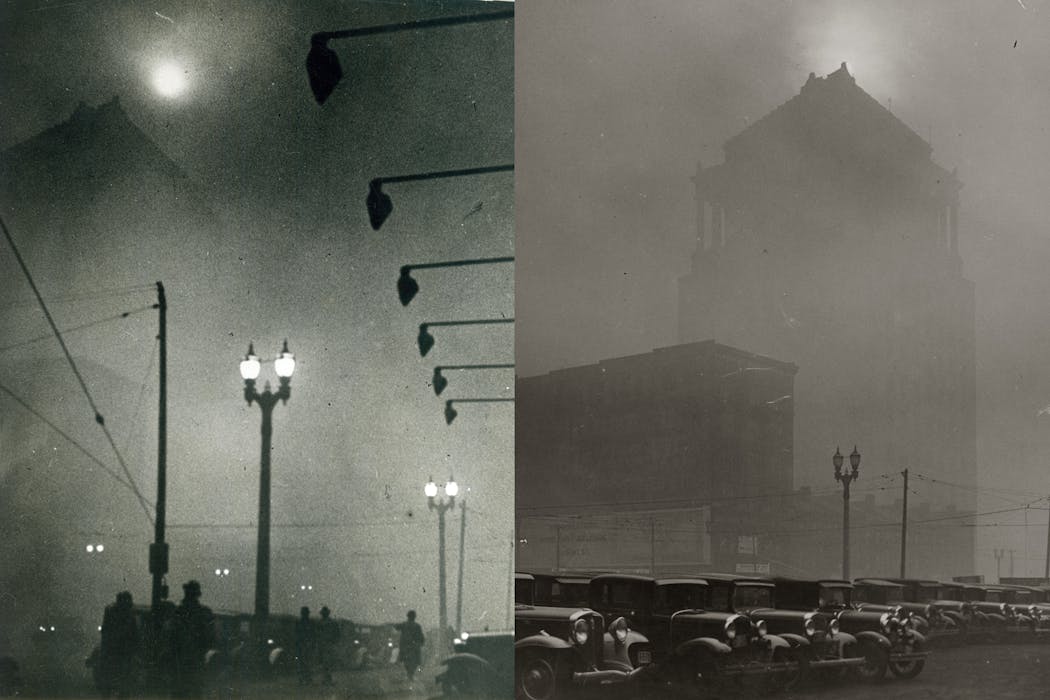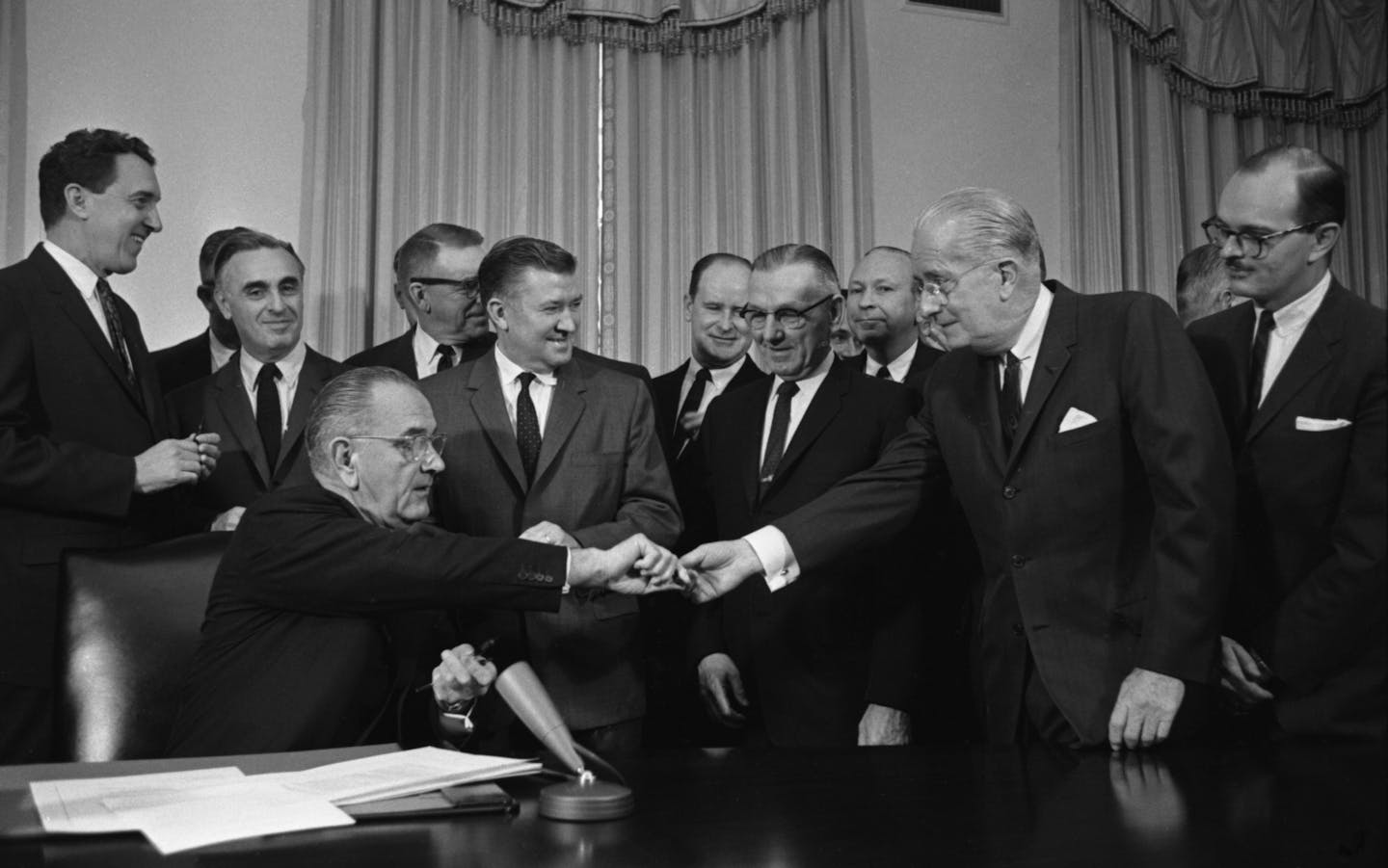
It was a morning unlike anything St. Louis had ever seen. Automobile traffic crawled as drivers struggled to peer through murky air. Buses, streetcars and trains ran an hour behind schedule. Downtown parking attendants used flashlights to guide vehicles into their lots. Streetlamps were ignited, and storefront windows blazed with light.
Residents called Nov. 28, 1939, “Black Tuesday.” Day turned to night as thick, acrid clouds blackened the sky. Even at street level, visibility was just a few feet. The air pollution was caused by homes, businesses and factories, which burned soft, sulfur-rich coal for heat and power. The soft coal was cheap and burned easily but produced vast amounts of smoke.
The murky morning was an extreme version of a problem St. Louis and dozens of other American cities had been experiencing for decades. Strict federal air pollution regulations were still 30 years away, and state and local efforts to limit coal smoke had failed miserably.
Today, as the Trump administration works to roll back air pollution limits on coal, the events in St. Louis more than 80 years ago serve as a reminder of how bad a situation can become before people’s objections finally force the government to act. And as I discuss in my book “Black Gold: The Rise, Reign and Fall of American Coal,” those events also highlight how successful that action can be.
A widespread civic effort
Days after Black Tuesday, St. Louis Mayor Bernard Dickmann responded to the crisis by creating a commission to investigate and recommend a solution to the continuing air pollution.
Just before Black Tuesday, Joseph Pulitzer II, publisher of the St. Louis Post-Dispatch, had launched his own anti-smoke newspaper campaign seeking fundamental change. In my research I found the first editorial, on Nov. 13, 1939, which declared “something must be done, or else.” A crack reporter, Sam J. Shelton, was assigned full time to what became the smoke beat. Post-Dispatch news stories, editorials and political cartoons championed the values of cleaner air and the dangers of toxic pollution.
Dickmann’s Smoke Elimination Committee met 13 times over a winter that seemed unrelenting in darkness. News and weather reports record that smoke blotted out the Sun on one out of every three days, and sometimes sunlight never pierced the darkness. Advice poured in, including from a Hollywood-style stuntman and flagpole sitter, Alvin “Shipwreck” Kelly, who offered to perch in the sky searching for dirty chimneys.
In late February 1940, the commission issued a report recommending restrictions on smoke emissions. The report said residents and industry should either pay more to buy coal with less sulfur or other fuel, or pay for and install new equipment to burn the sulfur-rich coal more cleanly. On April 5, the city’s Board of Aldermen convened to consider the changes in law that would enact the recommendations.
Newspapers reported that more than 300 protesters, including coal dealers, operators and miners, parked their trucks outside City Hall, waving banners. Black smoke spewed upward from coal stoves mounted atop one, newspaper reports said. The boisterous throng marched into City Hall, shouting and often drowning out city representatives. Amid catcalls and boos, the aldermen passed the ordinance 28-1.
Immediately, Raymond Tucker, the mayor’s deputy, began arranging for suppliers of more expensive low-sulfur coal for the city’s residents and businesses. He launched a slick public relations campaign urging residents to comply with the new law. He also hired a team of inspectors to block bootleg shipments of unauthorized sulfur-rich coal and to cite anyone whose chimney’s smoke ran too black.
Coal operators in Illinois, who sold the cheaper sulfur-rich coal, urged their state’s residents to boycott St. Louis goods and filed lawsuits challenging the legality of the new ordinance. Those actions appeared menacing but made little headway.
The true test of the ordinance would arrive with the winter chill.

A winter of change
As winter arrived, legal coal was 10% to 30% more expensive than the high-sulfur coal had been, and some families struggled, especially in poorer areas of the city. Bootleg coal shipments arrived. More than once, Tucker’s armed inspectors fired at a suspect truck that ignored orders to stop, according to newspaper reports from the time.
While hopes were already high that the new, tough measures would clean the skies, the winter of 1940-41 defied even those rosy expectations. By mid-January, the city’s skies were so much cleaner than the year before that they were the talk of the town. They were clear blue, and even on days when there was smoke, it was far less than had been common before the city ordinance passed.
The national press picked up the news, and arriving visitors wrote letters to the editors of their hometown newspapers reporting being astounded by what St. Louis had accomplished that winter. Tucker compiled notes on how many communities in the U.S. and Canada sought details on the transformation. In that document, now held among his archives at Washington University in St. Louis, he listed 83.
“A great city has washed its face,” Sam Shelton wrote for the Post-Dispatch. “St. Louis is no longer the grimy old man of American municipalities.” The “plague of smoke and soot” had been wiped away after a century in “a dramatic story of intelligent, courageous and co-operative effort.” No longer did residents have to endure “burning throats, hacking coughs, smarting eyes, sooty faces and soiled clothing.”
The newspaper was awarded a Pulitzer Prize for public service in 1941 for its campaign, the first time that a major award was conferred for an environmental story.
For years afterward, the coal industry argued that the St. Louis campaign was a fraud that needlessly forced residents to buy more expensive fuel and equipment. But even during World War II, when industrial restrictions meant pollution was worse in the name of driving the war economy, the city’s skies were never as blackened as they had been before.
Tucker, the mayor’s deputy, later used the fame he had achieved from the smoke campaign as a springboard to being elected mayor. He served 12 years. His former boss, Dickmann, was less fortunate, losing his reelection bid in 1941. He blamed it on having forced residents to pay more, even though it meant cleaner fuel for their homes and clearer skies for their community.
This article is republished from The Conversation, a nonprofit, independent news organization bringing you facts and trustworthy analysis to help you make sense of our complex world. It was written by: Robert Wyss, University of Connecticut
Read more:
- How poisonous mercury can get from coal-fired power plants into the fish you eat – Trump’s EPA plans to weaken emissions rules meant to lower the risk
- 3 reasons US coal power is disappearing – and a Supreme Court ruling won’t save it
- Pollution from coal power plants contributes to far more deaths than scientists realized, study shows
Robert Wyss does not work for, consult, own shares in or receive funding from any company or organization that would benefit from this article, and has disclosed no relevant affiliations beyond their academic appointment.


 The Conversation
The Conversation
 Local News in Texas
Local News in Texas The Outer Banks Voice Community
The Outer Banks Voice Community The Colorado Sun
The Colorado Sun KSL NewsRadio
KSL NewsRadio Santa Maria Times Safety
Santa Maria Times Safety Associated Press US News
Associated Press US News 9&10 News
9&10 News KNAU
KNAU The Hill
The Hill